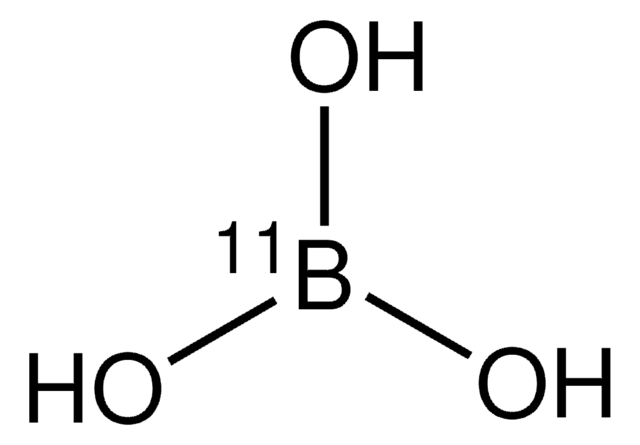202878
Boric acid
99.999% trace metals basis
Synonym(s):
orthoboric acid
About This Item
Recommended Products
vapor pressure
2.6 mmHg ( 20 °C)
Quality Level
Assay
99.999% trace metals basis
form
crystalline powder
mp
160 °C (dec.) (lit.)
solubility
water: 49.2 g/L at 20 °C
density
1.49 g/cm3 at 23 °C
SMILES string
OB(O)O
InChI
1S/BH3O3/c2-1(3)4/h2-4H
InChI key
KGBXLFKZBHKPEV-UHFFFAOYSA-N
Looking for similar products? Visit Product Comparison Guide
Related Categories
General description
Application
Boric acid finds uses in several areas; such as
- In glass fibres, to enhance its resistance and color
- In glazing ceramic wares
- As a condensing agent, chemical intermediate and as a precursor for preparation of borates and other boron based compounds
- As a water coolant in nuclear reactors
- In electrolytic condensers and capacitors 1
Packaging
Signal Word
Danger
Hazard Statements
Precautionary Statements
Hazard Classifications
Repr. 1B
Storage Class Code
6.1D - Non-combustible, acute toxic Cat.3 / toxic hazardous materials or hazardous materials causing chronic effects
WGK
WGK 1
Flash Point(F)
Not applicable
Flash Point(C)
Not applicable
Personal Protective Equipment
Regulatory Listings
Regulatory Listings are mainly provided for chemical products. Only limited information can be provided here for non-chemical products. No entry means none of the components are listed. It is the user’s obligation to ensure the safe and legal use of the product.
EU REACH SVHC Candidate List
EU REACH Annex XVII (Restriction List)
Certificates of Analysis (COA)
Search for Certificates of Analysis (COA) by entering the products Lot/Batch Number. Lot and Batch Numbers can be found on a product’s label following the words ‘Lot’ or ‘Batch’.
Already Own This Product?
Find documentation for the products that you have recently purchased in the Document Library.
Customers Also Viewed
Articles
Carbon Molecular sieves (CMS) are a versatile range of adsorbents that can be tailored for specific applications. Supelco® scientists have been synthesizing synthetic CMS carbons for several decades, starting from tailoring of the starting polymers/copolymers, to modifying the final properties of the subsequent CMS carbon.
Our team of scientists has experience in all areas of research including Life Science, Material Science, Chemical Synthesis, Chromatography, Analytical and many others.
Contact Technical Service


